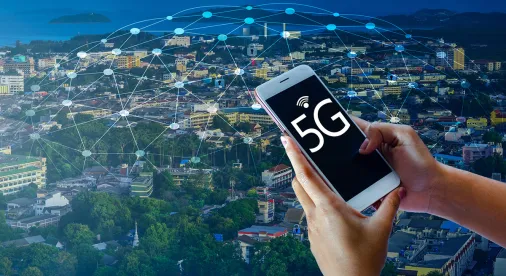The next-generation of wireless technologies – known as 5G – is here. Not only is it expected to offer network speeds that are up to 100 times faster than 4G LTE and reduce latency to nearly zero, it will allow networks to handle 100 times the number of connected devices, revolutionizing business and consumer connectivity and enabling the “Internet of Things.” Leading policymakers – federal regulators and legislators – are making it a top priority to ensure that the wireless industry has the tools it needs to maintain U.S. leadership in commercial 5G deployments. This blog provides monthly updates on FCC actions and Congressional efforts to win the race to 5G.
Regulatory Actions and Initiatives
COVID-19 Relief
-
The FCC grants emergency authorizations so that first responders and others can continue wireless infrastructure projects during the pandemic.
-
The FCC granted several additional requests for relief to FirstNet (see examples here and here), Verizon Wireless (see examples here and here), Humboldt County, CA, and Grant County, WI, to resume standard historic preservation review under Section 106 of the National Historic Preservation Act for qualifying critical infrastructure (e.g., public safety and transportation) projects during COVID-19.
-
Mid-Band Spectrum
-
Bidding in the FCC’s first auction of mid-band spectrum for 5G services concludes.
-
The FCC announced that bidding in its auction of Priority Access Licenses in the 3550-3650 MHz band concluded on August 25, 2020. It noted that gross proceeds reached approximately $4.585 billion and bidders won more than 91.1 percent of available licenses.
-
Subsequently, on September 2, 2020, the FCC released a Public Notice announcing the close of the auction with a summary list of the results for each bidder, including gross bids and number of licenses won, and a list of bidders’ payments and refunds.
-
-
The FCC adopts final procedures for its next auction of mid-band spectrum for 5G services and affords incumbents additional time to make lump sum payment elections while court challenges continue.
-
On August 7, 2020, the FCC adopted final procedures for the auction of spectrum in the 3.7-4.2 GHz band (“C-band”), with only two substantive changes from the draft procedures it released in July. Those changes include how a bidder’s activity will be calculated during bidding and how missing bids will be treated.
-
In response to a request from the Society of Broadcast Engineers, the FCC released an Order on August 20, 2020, extending the deadline by which earth stations relocating from the C-band must elect whether to receive a lump sum payment from August 31 to September 14, 2020. On August 31, 2020, the FCC also released an Order denying a request by America’s Cable Association to stay the deadline for the lump sum elections, but that decision has no impact on the prior extension – i.e., lump sum elections remain due September 14, 2020.
-
At the D.C. Circuit, the FCC filed its brief in response to ABS Global Ltd., Empresa Argentina de Soluciones Satelitales S.A., Hispamar Satelites S.A., and Hispasat S.A. (together, the “Small Satellite Operators”) and PSSI Global Services, LLC’s joint opening brief on August 28, 2020. In its brief, the FCC argues, among other things, that it reasonably exercised its power under Section 316 to modify the incumbent satellite operators’ licenses, its decision complies with notice-and-comment requirements, and it reasonably explained its decision to authorize the $9.7 billion accelerated relocation payment. The parties’ final briefs are due September 16, 2020. Oral argument on the appeals will take place on October 28, 2020. In a separate D.C. Circuit proceeding, ACA Connects filed a petition for writ of mandamus to stay the September 14, 2020 deadline for earth station operators’ lump sum election.
-
-
FCC Chairman Pai announces that an auction of mid-band spectrum in the 2.5 GHz band can be expected next year.
-
In his statement accompanying the procedures the FCC adopted for the C-band auction (see above), FCC Chairman Pai stated that he expects the FCC will move forward with scheduling a 2.5 GHz auction “in the first half of 2021.”
-
-
The White House announces that 100 megahertz of mid-band spectrum will be made available for commercial 5G deployment next year.
-
On August 10, 2020, the White House announced and released a fact sheet reporting that 100 megahertz of spectrum between 3450-3550 MHz, currently used by the Department of Defense, will be made for commercial use. That same day, FCC Chairman Pai released a statement indicating that “[t]ogether with the spectrum being made available for 5G in the C-band as well as the 3.5 GHz band, we are now on track to have a 530-megahertz swath of mid-band spectrum available for 5G from 3.45 to 3.98 GHz.”
-
An auction of the spectrum is expected to commence in December 2021, allowing commercial deployments in mid-2022.
-
-
An FCC report on the use of spectrum by drones is released.
-
On August 27, 2020, the FCC announced that a report on spectrum usage for unmanned aircraft system (“UAS”) operations – commonly known as drones – was released, finding that the 5030-5091 MHz band is suitable for such operations and recommending that the FCC begin a rulemaking to develop service and licensing rules enabling UAS use of that band.
-
5G Equipment and Infrastructure
-
The Ninth Circuit upholds the FCC’s 5G Wireless Infrastructure Orders.
-
On August 12, 2020, the United States Court of Appeals for the Ninth Circuit issued a decision largely upholding the Commission’s 2018 Declaratory Rulings on wireless infrastructure deployment and one-touch-make-ready.
-
The Ninth Circuit’s decision affirmed the FCC’s Declaratory Rulings establishing several key issues to support the deployment of communications infrastructure, including:
-
The Commission’s clarification of the correct standard for evaluating whether a local government action is an “effective prohibition” under Sections 253 and 332 of the Communications Act. Under the FCC’s clarification, a local government requirement or action violates the effective prohibition clauses if it materially inhibits or limits the ability of a provider to densify a wireless network, introduce new services, or otherwise improve service capabilities.
-
The Commission’s action also declared that the “significant gap/evaluation of alternatives” standards that had been adopted by numerous courts were incorrect.
-
-
The Commission’s ruling limiting local government fees for access to public rights of way and local government infrastructure in the rights of way (e.g., poles).
-
The Commission’s ruling that local government regulations must be “reasonable,” and to be reasonable the regulation must be technologically feasible.
-
The Commission’s declaration that explicit and de facto moratoria violate the Act.
-
Several key pole attachment issues, including the Commission declaration confirming that utilities cannot require new attaching parties to pay the cost of correcting pre-existing conditions.
-
-
The Court, however, struck down the small cell wireless deployment Order to the extent it held that local aesthetic regulations are required to be “objective” and imposed equally on all other infrastructure. The Court’s ruling did not eliminate the potential that local government requirements may be unlawfully discriminatory.
-
Events
-
The FCC reschedules the 5G Open Radio Access Forum to September 14, 2020.
-
The FCC rescheduled its forum on the current state of 5G Open Radio Access Networks (“O-RAN”) and O-RAN-related technologies to September 14, 2020 at 10:30 am. The forum was initially scheduled for March 26, 2020, but was postponed due to the COVID-19 pandemic. Speakers at the forum include Chairman Pai, U.S. Secretary of State Michael R. Pompeo, and representatives from across the industry. The forum will be virtual and will available by videoconference and livestream.
-
-
NTIA will host its annual Spectrum Policy Symposium on September 22, 2020.
-
NTIA announced that it will hold its annual Spectrum Policy Symposium on September 22, 2020. Speakers at the symposium include staff from NTIA’s Office of Spectrum Management and the White House Office of Science and Technology Policy. The symposium is free and will be available by webcast.
-
Legislative Efforts
-
A bill was introduced in the House and Senate that would grant Tribal nations access to spectrum licenses over Tribal lands, eliminating the FCC’s ability to auction that spectrum.
-
On July 24, 2020, Representative Haaland introduced the DIGITAL Reservations Act. If enacted, the bill would eliminate the FCC’s role in selling spectrum rights on Tribal land without Tribal consent. The bill would also create the Tribal Broadband Fund, which would require the FCC to fund network and infrastructure buildout on Tribal lands through universal service contributions, spectrum auctions, and other sources. A companion bill – S. 4331 – was introduced by Senator Warren on July 27, 2020.
-








 />i
/>i

